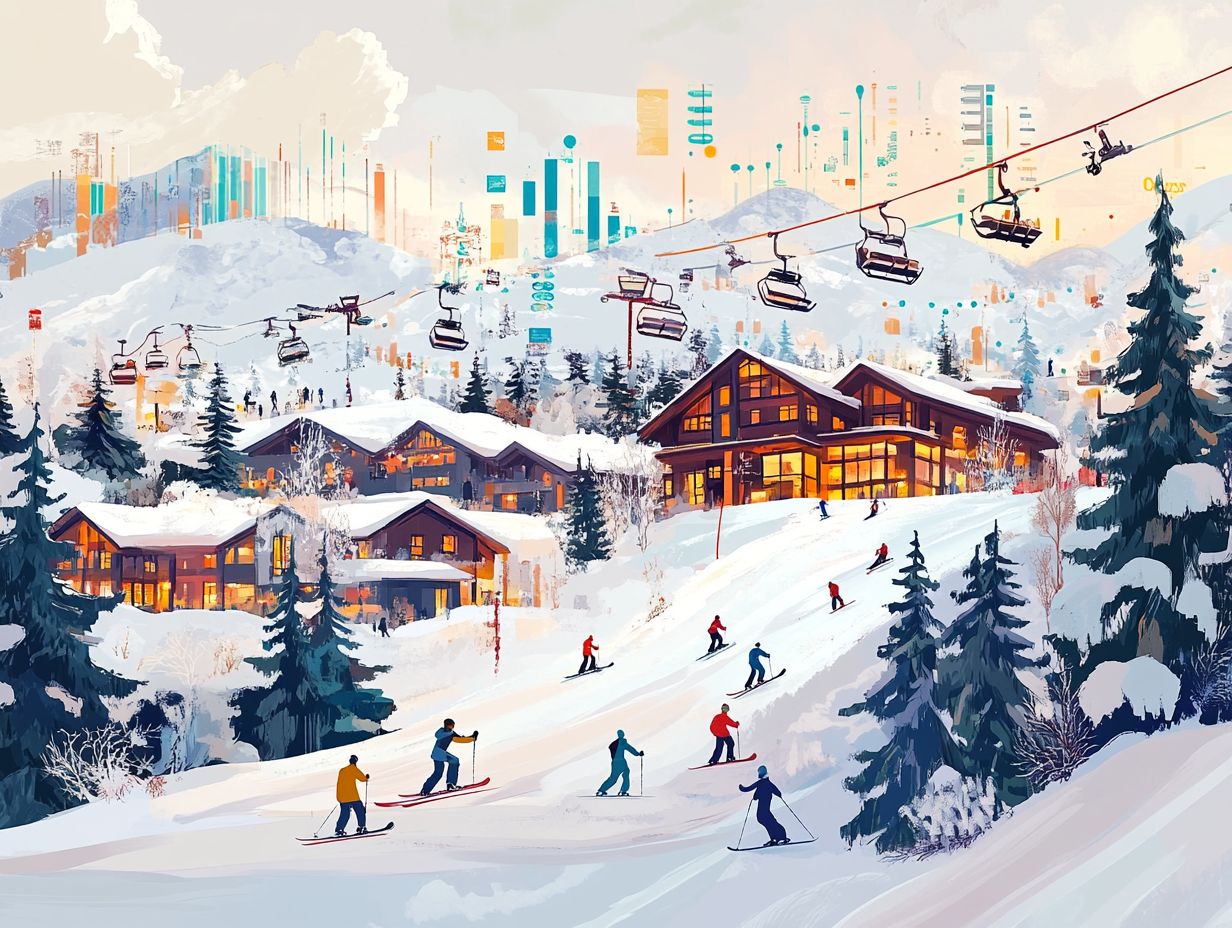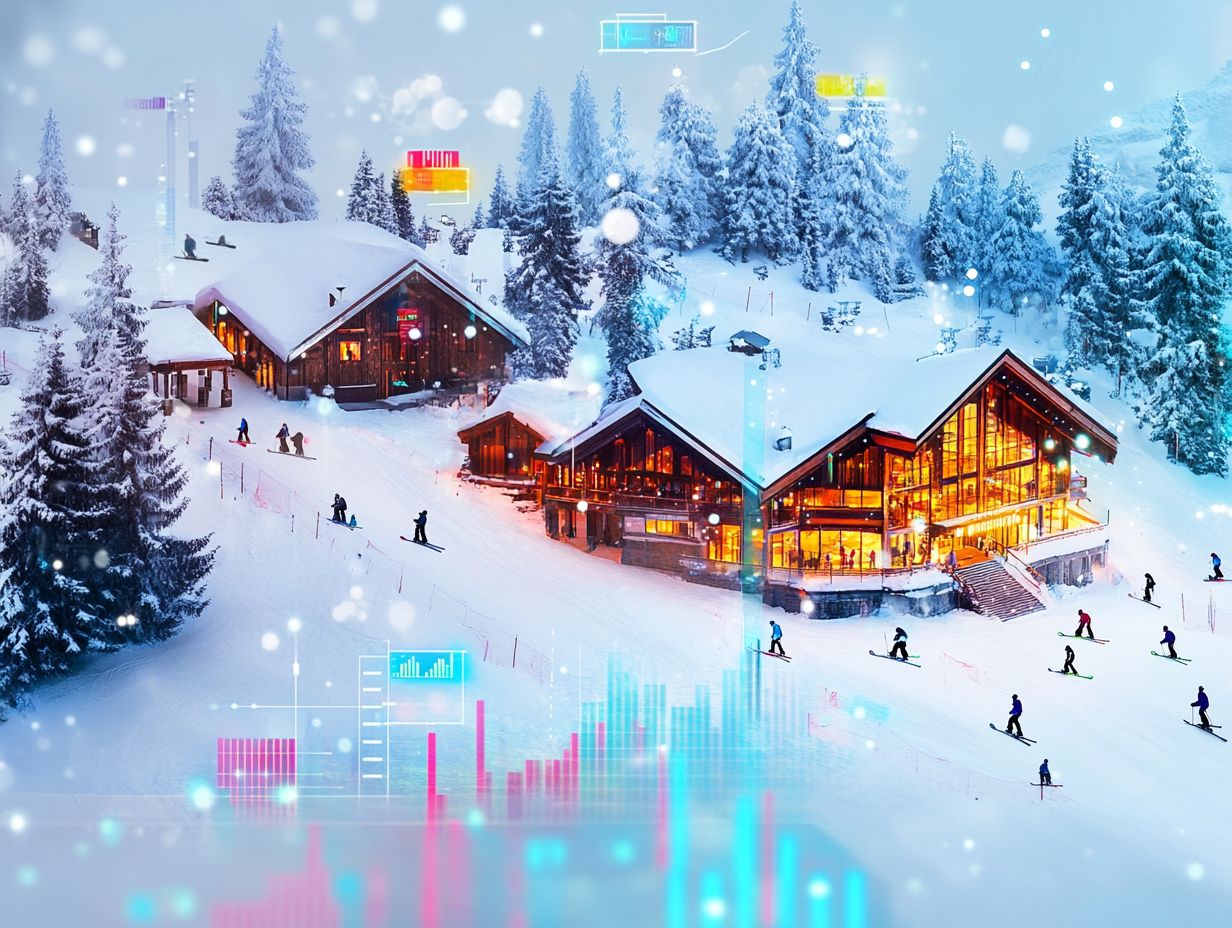The significance of foot traffic analytics for ski resorts lies in its capacity to enhance the understanding of customer behavior through thorough market research and data analysis. In a competitive environment like ski resort marketing, knowledge of customer behavior is essential. Foot traffic analytics offers valuable insights into the patterns of a resort’s foot traffic, revealing important parameters such as customer preferences, visitor insights, and movements. This discussion highlights the benefits of foot traffic analytics for ski resorts, including the ability to gain a deeper understanding of customer behavior, identify peak times, and refine marketing strategies through effective marketing optimization and audience targeting. By utilizing the right tools and data, resorts can transform their approach to understanding customer behavior, ultimately leading to improved customer experiences, more targeted promotions, and enhanced visual analytics.
What is Foot Traffic Analytics?

Foot traffic analytics involves the systematic collection and analysis of data regarding the movement patterns and behaviors of visitors to locations such as ski resorts. By utilizing various tools and technologies, operators can gain valuable insights into visitor demographics, traffic patterns, and customer engagement metrics, which can enhance operational efficiency and inform strategic planning including event marketing. Data visualization techniques and heat mapping technology are employed to illustrate trends and improve the guest experience.
- Mobile Tracking: This methodology utilizes anonymized device IDs to monitor how individuals navigate through a site over time. It helps create heat maps that highlight peak times and areas of interest.
- Demographic Segmentation: Businesses can categorize their visitor base by age, gender, skiing demographics, or spending habits, enabling them to tailor their marketing efforts to be more relevant to different audience segments through effective customer segmentation.
Why is it Important for Ski Resort Marketing?
Foot traffic analytics play a crucial role in ski resort marketing by providing valuable insights into customer behavior, preferences, and consumer engagement. This information allows operators to develop tailored marketing strategies that resonate with their target audience. By understanding visitor demographics and traffic patterns, ski resorts can optimize promotional campaigns, seasonal promotions, and enhance brand awareness, helping them remain competitive in the ever-evolving skiing industry.
These analytics enable resorts to identify peak times and popular areas on their property, which is particularly useful for planning staff allocation and resource distribution. A deep understanding of visitor behavior allows resorts to create customized promotions or incentives that encourage guests to return, fostering brand loyalty and visitor retention.
By adapting to emerging tourism trends, resorts can attract diverse visitors, such as avid skiers or families seeking winter activities, thereby fostering a community around their brand and leveraging tourism analytics.
Utilizing foot traffic data not only improves the guest experience but also positions the resort as a leader in the skiing market through strategic partnerships and business intelligence.
Benefits of Using Foot Traffic Analytics for Ski Resort Marketing

Foot traffic analytics offer several benefits for ski resorts, including improved sales through optimized marketing and operational decisions, enhanced customer engagement via real-time service adjustments, and the ability to conduct effective competitive analysis and market segmentation.
By leveraging foot traffic analytics, ski resorts can refine their marketing and operational strategies based on insights into customer engagement, preferences, and visitor patterns. These data-driven insights have the potential to boost sales and enhance the overall guest experience.
Additionally, foot traffic analytics enable ski resorts to make real-time service adjustments that significantly improve customer engagement and social media advertising. Such adjustments may involve:
- Modifying on-site amenities
- Expanding retail space
- Enhancing pick-up areas to alleviate congestion
Furthermore, resorts can use foot traffic analytics for effective competitive analysis and marketing attribution. By analyzing customer behavior patterns, they can gain insights into their competitors’ market positioning and seize promotional opportunities during peak demand periods using location-based marketing and geographic analysis.
Understanding Customer Behavior and Preferences
A deep understanding of customer behavior and preferences is essential for ski resorts to enhance their offerings, optimize the customer journey, and maximize visitor satisfaction.
By leveraging visitor insights and demographic segmentation, resorts can create targeted advertising campaigns aimed at specific visitor profiles, ultimately optimizing the customer journey, fostering brand loyalty through well-designed loyalty programs, and improving user experience.
This approach not only aids in identifying the preferences of different skier demographic groups but also helps forecast their needs at various interaction points throughout their journeys using actionable insights and real-time data.
For instance, incorporating data-driven insights into the development of personalized packages can significantly boost overall engagement, conversion rates, and encourage repeat visits.
Resort management can utilize technological tools such as CRM systems to capture visitor interactions, which can then be used to refine marketing strategies, improve customer feedback, and minimize friction during the customer journey.
Furthermore, customizing loyalty programs to include rewards based on frequency and spending patterns can foster a sense of exclusivity, thereby enhancing visitor retention, satisfaction, and loyalty rewards.
Identifying Peak Times and Popular Areas

Identifying peak times and popular areas within a ski resort is essential for effective resource management, maximizing ski pass sales, and optimizing ski resort management. By analyzing traffic patterns and visitor flow throughout different seasons, resorts can create targeted marketing strategies that take advantage of seasonal trends, ensuring efficient crowd management, better marketing attribution, and an enhanced guest experience.
Understanding these dynamics not only optimizes staff allocation but also improves operational efficiency, enabling resorts to anticipate busy periods, enhance user engagement, and prepare accordingly. Such insights give the power to teams to provide better customer service, reducing wait times, enriching the overall experience for visitors, and improving sales forecasting.
Utilizing data on peak visitation times also aids in forecasting revenue potential, making it easier for resorts to plan promotions, dynamic pricing strategies, and offline analytics that attract more guests during off-peak periods. In essence, a comprehensive understanding of visitor flow transforms ski operations management, maximizes profitability, and enhances strategic partnerships.
Implementing Foot Traffic Analytics at Ski Resorts
Foot traffic analytics at ski resorts is conducted using the appropriate tools and technologies that facilitate effective data collection, heat maps, and analysis.
These analytics are enhanced through advanced data analysis methodologies, which optimize marketing strategies, track performance metrics, and engagement metrics to improve operational efficiency and customer satisfaction.
Choosing the Right Tools and Technology

The importance of tools and technology for foot traffic analytics lies in their ability to enable ski resorts to effectively monitor and analyze visitor behavior, dwell time, and traffic flow.
Technology options such as mobile tracking devices, data visualization software, and mobile marketing give the power to ski resorts to capture analytics that enhance operational efficiencies and improve guest experiences.
These technologies facilitate real-time tracking of visitor patterns and allow for the integration of data into existing management systems, optimizing various operations and improving marketing attribution.
Features like intuitive dashboards and customizable reporting options help staff interpret complex data easily, making it accessible to those without technical backgrounds, ultimately enhancing user data understanding.
Ensuring compatibility with a wide range of mobile tracking solutions supports a more holistic approach to data collection, aiding in strategic decision-making, and improving marketing analytics.
Ultimately, tools and technology play an essential role in creating a more engaging environment where every guest can enjoy a memorable experience, enhancing user experience, and customer insights.
Collecting and Analyzing Data
Collecting and analyzing data effectively is crucial for ski resorts to leverage foot traffic analytics, conduct KPI analysis, and make informed marketing decisions.
When ski resorts employ robust data collection and analysis methods, they can gain insights into visitor profiles, thereby improving their conversion rates and advertising return on investment (ROI), through effective digital marketing and influencer marketing. Advanced tools such as customer relationship management (CRM) systems, data visualization software, survey platforms, and digital footprint tracking can enhance data collection and analysis efforts.
Methodologies like A/B testing provide valuable insights into the effectiveness of various marketing strategies, enabling ski resorts to monitor their marketing performance in real-time and improve campaign effectiveness.
By continuously tracking customer habits and preferences, ski resorts can tailor advertisements, social media advertising, and package offerings to better align with visitors’ specific interests and needs. Keeping data at the forefront will give the power to decision-makers to devise strategies that optimize resource utilization, ultimately enhancing overall profitability, and email marketing while also increasing customer satisfaction.
Using Foot Traffic Analytics to Enhance Marketing Strategies
Marketing Strategies: Ski resorts can leverage foot traffic analytics to enhance their marketing strategies.
By utilizing this data, ski resorts can refine their promotional campaigns, content marketing, and targeted advertising initiatives, ultimately focusing on improving customer experience and satisfaction.
Targeted Advertising and Promotions
Targeted advertising and promotions are essential strategies that ski resorts can use to enhance the effectiveness of their marketing efforts including cross-channel marketing and lead generation.
By leveraging foot traffic analytics and visitor insights, these ski resorts can identify specific audience segments and optimize their marketing strategies to deliver personalized offers, thereby increasing customer engagement and ROI through user-generated content and relevant promotions.
Such strategies enable ski resorts to tailor their messages using demographic profiling to families, young adults, or seasoned skiers, ensuring that the content resonates with their interests and preferences. This approach leverages data analysis to comprehend customer behavior and seasonal trends.
For example, a ski resort might utilize data insights and tourism analytics to target families seeking winter holiday packages by offering discounts on group lessons and lodging. A successful case study from Aspen Skiing Company demonstrated that by employing advanced analytics and customer segmentation to segment their audience, they achieved a significant increase in booking rates and conversion rates during the peak ski season.
Likewise, utilizing social media advertising for targeted advertisements aimed at young adventure-seekers can drive consumer engagement, as they share their experiences, ultimately contributing to word-of-mouth marketing and increased brand awareness and visibility.
Improving Customer Experience and Satisfaction
Enhancing user experience and guest satisfaction is essential for ski resorts that aim to encourage repeat visits and foster brand loyalty. By utilizing foot traffic analytics and visitor patterns to understand visitor preferences, ski resorts can create experiential marketing initiatives and community outreach programs that meet those needs, leveraging insights from visitor behavior analysis.
Furthermore, they can introduce loyalty programs and other incentives like loyalty rewards to enhance the overall guest experience. Monitoring guest behavior trends with offline analytics and strategic partnerships enables ski resorts to adjust their offerings, ensuring that guests feel appreciated and valued.
Engaging with customers through surveys and feedback tools allows ski resorts to gain a deeper understanding of their expectations, thereby nurturing a culture of responsiveness. Offering fun and unique experiences, such as themed events, event marketing, or strategic partnerships with local businesses, can further strengthen the sense of community.
By maintaining open lines of communication and involving guests in decision-making processes, ski resorts can achieve higher satisfaction rates and cultivate a loyal customer base. Such engagement metrics are likely to lead to positive experiences shared within their social networks, enhancing the resort’s online presence.






